

Perspectives from Patients and Providers Indiana Clinical and Translational Sciences Institute 2021 Annual Meeting Jennifer K Maratt MD MS 1 Mentors Thomas F Imperiale MD 1 Marianne S Matthias PhD ID: 908215
Download Presentation The PPT/PDF document "Low-risk Adenoma Surveillance Decision-m..." is the property of its rightful owner. Permission is granted to download and print the materials on this web site for personal, non-commercial use only, and to display it on your personal computer provided you do not modify the materials and that you retain all copyright notices contained in the materials. By downloading content from our website, you accept the terms of this agreement.
Slide1
Low-risk Adenoma Surveillance Decision-making: Perspectives from Patients and Providers
Indiana Clinical and Translational Sciences Institute 2021 Annual Meeting
Jennifer K. Maratt, MD, MS
1
Mentors:
Thomas F. Imperiale, MD1Marianne S. Matthias, PhD11Department of Medicine, Indiana University School of Medicine; Richard L. Roudebush VA Medical Center; Regenstrief Institute, Inc.
Acknowledgment: Indiana Clinical and Translational Sciences Institute (KL2 Program), UL1TR002529 (S. Moe and S.
Weihe
, co-PIs), 5/18/2018 – 4/30/2023
Slide2BackgroundColonoscopy is an important tool for screening and surveillance in gastroenterology (GI)
Common indication for surveillance colonoscopy: post polyp resectionHowever, not all polyps are the sameHigh vs low risk adenomas (high vs low risk of future colorectal cancer)Surveillance colonoscopy is underused for high risk adenomas, overused for low risk adenomasWhat role do patients and providers play? What role do they want to play?
Slide3BackgroundThe primary aim of this study is to understand patient and provider perspectives for decision-making for low-risk adenoma surveillance colonoscopy.
Domains covered will include: Perceived involvement with decision-making for surveillanceContent of pre-procedure discussionsPatients’ barriers & facilitators to undergoing colonoscopy
Slide4MethodsQualitative approach: semi-structured, one-on-one virtual interviewsPatients and providers at Richard L. Roudebush VA and
Eskenazi:Patients: 50-75 years of age; screening colonoscopy at the VA or Eskenazi with finding of low-risk adenomasPrimary care providers and gastroenterologistsPlanned to recruit 8 patients and 8 providers per siteThematic saturationData collection and analysis: Immersion-crystallization framework
Slide5Results
ThemePrimary Care Providers (n=8)Gastroenterologists (n=6) Timing of surveillanceMost PCPs believed that guidelines were difficult to keep up with, therefore, rarely use them in practice. Most rely on either colonoscopy reports, pathology letters, and/or reminders through EHR for timing of repeat colonoscopy.If interval recommended is a range of years, then most will recommend shortest interval.Some believed that giving PCPs a range of years for surveillance interval could confuse them.When a range of years is recommended based on guidelines (i.e., 7-10 years for LRAs), most recommend the shortest interval within the range.If a patient presents before they are due, most proceed with the colonoscopy unless patient prefers otherwise.
Pre-procedure discussionsFew have in-depth discussions aside from whether or not to proceed.
PCPs expressed greater comfort with benefits discussion (vs. risks).
Many defer in-depth discussions to GI. Informed consent obtained at time of meeting patient right before colonoscopy.
All elements discussed except most believed that a discussion about alternatives not relevant at that time and place more emphasis on risks (vs benefits).Surveillance decision-makingWhen asked whose domain surveillance decision-making is currently in, most believed that it was either shared equally between GIs and PCPs, or more in GI’s domainWhen asked whose domain it should be in, most said GI where as few said PCP
When asked
whose domain surveillance decision-making is currently in
, all believed that it was in GI’s domain
When asked
whose domain it should be in
, most said GI where as few said PCP
Patients for whom decision-making is perceived as difficult
Older adults
Those with multiple comorbidities, on anticoagulation
Those who are hesitant/reluctant
Older adults
Those with multiple comorbidities
Frail adults
When to stop surveillance
Slide6Results
ThemePatients (n=16) Timing of surveillance/involvement with surveillance decision-makingMost felt very involved in the decision-making although relied heavily on PCPs’ recommendations.Most rely on PCPs to remind them when they are due (in VA—many also recalled receiving a reminder letter in mail). Trust in PCPs cited as most common reason. Pre- and post-procedure discussionsMost do not recall pre-procedure discussions, including indication, risks, alternatives.Most recalled receiving letters with results, few recalled details of letters.Difficulty with recollection of recommended surveillance intervalBarriers to undergoing colonoscopyCultural – some prefer home remedies over Western medicine
Hearing about bad experiences through social networksBowel preparation
Facilitators to undergoing colonoscopy
Ease of testSocial support through relatives, friendsHaving a driverFeeling engaged in their own healthcare
Slide7Future DirectionsNeed to understand decision-making for high-risk adenoma surveillance Findings from these studies will be used to develop an intervention to optimize efficiency of endoscopy use